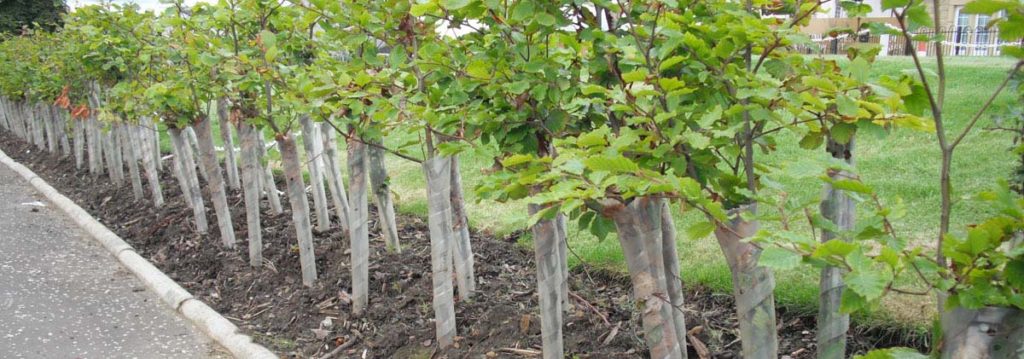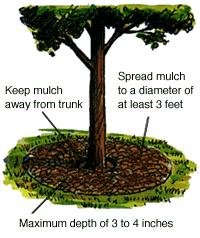Once your trees are in the ground they’ll need care and maintenance.

Short term management
Mulching
Wood chips or straw around the base of the tree all help to stop weeds growing. This is really important in the first few years of a tree’s life as grass and other plants compete against the saplings.
Mulch also
- insulates the soil helping to provide a buffer from heat and cold
- retains water helping to keep roots moist
- prevents soil compaction
- reduces the potential for lawn mower damage
Steps to adding mulch around your tree
- Add mulch to the base of your tree by removing any grass within a three to ten foot area depending on the size of your tree
- Pour mulch two to four inches deep within the circle
- Keep mulch from touching the trunk of the tree

Selecting woodchips,
Ramial (2 inches diameter branches and under) is great fresh or aged. Wood chips are either from bark, thicker branches or stems should be left at least for one year in a pile until white fungi are built. Otherwise the wood chips rob the soil of nitrogen, which the bacteria/fungi use to break down carbon, making the carbon unavailable to the tree. This is especially important if the wood chips come from conifers.
Watering
You should only need to water your trees after a very long dry spell. The trees should adapt to the site and shouldn’t need additional water in normal conditions.
Tree guards
Make sure that your tree guards are upright and pushed firmly into the soil. Remove any grass growing inside the guard. Once the tree has grown to over 3m, remove the guard. If they remain intact, you can use these guards again to protect any more young trees you plant.
Pests and diseases
Pests and diseases can also cause damage inside the guards, so check the tree stems and guards regularly. Keeping tree guards firmly in contact with the soil, and a weed-free area around your trees, will help. If you suspect tree disease, please email DEFA.
Fencing
Keep livestock away from your planting area with fencing.
Long term management
Pruning
This is not essential but it will encourage trees to grow upwards rather than outwards.
Invest in a good pruning saw and make a clean cut close to the main trunk of the tree. The cut should be made square to the branch and preserve the bulge at the base of the branch, known as the branch collar. To prevent disease and decay, it is important not to damage the bark of the tree. Never cut the branch flush with the main stem as this creates a larger wound. If unsure, always seek expert advice. Most native trees are best pruned in winter when dormant, except field maple, cherry and walnut which need pruning in summer to reduce risk of disease and sap bleeding.
Coppicing
This involves cutting a tree near to its base to encourage new growth. Your trees could be ready to coppice after 7–10 years, depending on species and growth rate. You can use this management practice to achieve a sustainable supply of wood fuel and other woodland products. The remaining coppice stool will be vulnerable to animal browsing so make sure you protect the new growth.
Thinning
Thinning wouldn’t usually occur until year 10 at the earliest but it depends on how close together the trees were planted. It involves felling some of your planted trees to reduce the competition for light, water and nutrients. By giving the remaining trees more room they develop a better shape, grow stronger and are less likely to blow over in adverse weather